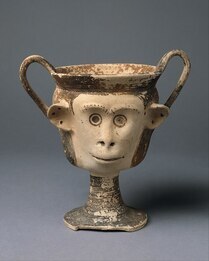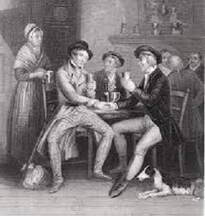David Tickner's Blog, page 16
January 31, 2023
Octothorpe
 What do you call the # symbol on your phone? The pound sign? The number sign? The hash sign? The octothorpe?
What do you call the # symbol on your phone? The pound sign? The number sign? The hash sign? The octothorpe? The pound sign #, meaning a weight in pounds, comes from Latin libra pondo, abbreviated as lp, which ended up in English as ‘lb’. If you look carefully at ‘lb’, you can almost see a #. The term ‘pound sign’ is from US usage in the 1930s.
The number sign #, meaning a number, has its origins in an 1853 treatise on bookkeeping. In an 1890s typewriter manual, # was known as the ‘number mark’. Later sources refer to the ‘number sign’. [Bonus factoid: Bookkeeping is the only word in English with three consecutive double letters].
What is the difference between # as a pound sign and # as a number sign? When # is used after a number, it means a weight in pounds; e.g., a 5# bag of flour = a five-pound bag. On the other hand, when # is used before a number (e.g., a #2 pencil), you would say, “A number 2 pencil.”
What about the # symbol in music referring to the term ‘sharp’; e.g., C# means ‘C sharp’. The # is used because of its resemblance to the glyph ♯ used in musical notation.
Hashtag? Hash, meaning a stew of meat cut into small pieces, is from the 1660s. Hash, meaning a mess, is from 1735. Hash marks on a football field were first called as such in 1954.
The hash sign #, in computing, is from 1979.The use of hashtags in social media was first proposed in 2007. A ‘hashtag’ is the message that follows the hash sign. In 2014, the Oxford English Dictionary defined hashtag as “a word or phrase with the symbol # in front of it, used in social media websites and apps so that you can search for all messages with the same subject.”
How about calling the # symbol an octothorpe? This term was first used by the tele-communications industry in 1971 in reference to the # symbol on a phone following the advent of touch-tone dialing in the 1960s. Octo- refers to the eight points on the # symbol. The origins of the -thorpe part of octothorpe are unknown. Thorpe is an Old English word for a village or hamlet, if this helps at all to explain the term!
When I was a kid, # simply meant the start of a game of x’s and o’s or ‘tic tac toe’.
Image: The abbreviation written by Isaac Newton, showing the evolution from "℔" toward "#".
Reference: Online Etymological Dictionary, https://www.etymonline.com/
https://en.wikipedia.org/wiki/Number_sign
https://en.wikipedia.org/wiki/Hashtag
Published on January 31, 2023 12:49
January 26, 2023
Saraswati
 Today, 26 January 2023, marks the celebration of Saraswati.
Today, 26 January 2023, marks the celebration of Saraswati.Saraswati is the Hindu goddess of knowledge, music, arts, science and technology, speech, wisdom, and learning. Some people worship Saraswati to gain enlightenment or simply to get rid of lethargy, sluggishness, and ignorance.
The word saraswati is from a Sanskrit root saras (pooling water; or, sometimes translated as speech).
Image: Painting of Saraswati by Raja Ravi Varma (1848 – 1906).
Reference: Online Etymological Dictionary, https://www.etymonline.com/
https://en.wikipedia.org/wiki/Saraswati
Published on January 26, 2023 21:43
January 23, 2023
Orange
 Knock, knock. Who’s there? Orange. Orange who?
Knock, knock. Who’s there? Orange. Orange who?Orange you glad you asked about the origins of the word orange?!
The word orange appears in English in the late 14th century in reference to the fruit of the orange tree and comes from Old French orange or orenge and medieval Latin pomum de orange. Latin pomum (apple) and Old English appel were generic names for any kind of fruit; that is, pomum de orange is the apple or the fruit of the orange tree.
Medieval Latin pomum de orange has its origins in Italian arancia, Venetian naranza, Arabic naranj, Persian narang, and Sanskrit naranga-s; all meaning an orange tree. Beyond this, the origins of the word orange are uncertain.
It is probable that orange trees first appeared in northern India. Persian oranges grown in 11th century Italy were bitter. Sweet oranges brought to Europe from India in the 15th century by Portuguese traders quickly displaced these bitter oranges.
Oranges and other citrus fruits were introduced into the Caribbean in the 1490s and into Spanish Florida in the 1510s. Oranges were introduced into Hawaii in 1792.
The word orange was not used as the name for a color until the 1510s. At that time, the term ‘orange color’ referred to any reddish-yellow color like that of a ripe orange. Before that time, similar orange-like colors were referred to as citrine or saffron.
In the 1660s, Sir Isaac Newton, in his examinations of the rainbow-like spectrum of light, somewhat arbitrarily determined that there were seven colours. Orange was the name given to the color between red and yellow.
‘Orange juice’ is from 1723; that is, the juice of an orange, not the juice that is orange in color!
Reference: Online Etymological Dictionary, https://www.etymonline.com/
Published on January 23, 2023 19:32
January 20, 2023
Stigma
 The word stigma has its origins in the Proto-Indo-European (PIE) root steig (to stick, to pierce). Greek and Latin both used the word stigma to refer to a mark, puncture, tattoo, or brand made by a pointed instrument.
The word stigma has its origins in the Proto-Indo-European (PIE) root steig (to stick, to pierce). Greek and Latin both used the word stigma to refer to a mark, puncture, tattoo, or brand made by a pointed instrument.The verb ‘to stigmatize’, meaning to brand or tattoo, is from the 1580s.
The noun stigma (a mark made on the skin by burning with a hot iron) came to English in the 1590s unchanged from its Greek and Latin origins. In such cases, a stigma was a permanent mark of disgrace on a person’s body.
The word stigmatism, meaning a branding, is from the 1660s. Stigmatism meaning the condition of being affected with stigmata (13th century: wounds which seemed to appear supernaturally on a person's body) is from 1897.
The word ‘astigmatism’, a medical term coined in 1849, refers to a defect in the structure of the eye whereby the rays of light do not converge to a point upon the retina. From Greek a- (without) + stigmatos (a point, a spot) = without a spot; i.e., unfocused.
The concept of stigma as a social phenomenon first appeared in the late 19th century; e.g., in an 1895 study by the sociologist Emile Durkheim. Social stigmas occur in many forms. For example, individuals who are stigmatized by culture, gender, race, religion, illness, or disease usually feel different from and devalued by others.
Today, a stigma is often characterized by shame or disgrace, a scar burned onto a person’s mind rather than onto their body.
A stigma is also part of a plant, but that’s another story.
(I am reminded of similarities between the words stigma and trauma. Both have their origins in ancient words related to physical damage and pain. Seemingly only in the 20th century did these words also come to mean mental damage and pain.)
Reference: Online Etymological Dictionary, https://www.etymonline.com/
https://en.wikipedia.org/wiki/Social_stigma
Published on January 20, 2023 14:37
January 16, 2023
Pun
 The word pun first appears in English in the 1660s. The verb ‘to pun’ or ‘to make puns’ is also from the 1660s. The origins of the word pun are uncertain.
The word pun first appears in English in the 1660s. The verb ‘to pun’ or ‘to make puns’ is also from the 1660s. The origins of the word pun are uncertain.Briefly, a pun is defined as a word used in two different applications or the use of two different words pronounced alike or nearly alike to produce an odd, silly, or ludicrous idea. For example, someone told me about growing maize the other day. It was amazing—the corniest thing I’d heard in quite a while.
Comparatively speaking, English, as spoken today, is a very young language and took its present form only five or six hundred years ago thanks to the likes of Gutenberg, Shakespeare, and the KJV Bible. During the 16th and 17th centuries, as more and more people became literate, they enjoyed playing with this new form of the language.
The Online Etymological Dictionary states,
“At the revival of learning, and the spread of what we may term the refinement of society, punning was one of the few accomplishments at which the fine ladies and gentlemen aimed… [by] the sixteenth century, it was at its greatest height. The conversation of the witty gallants, and ladies, and even of the clowns and other inferior characters, in the comedies of Shakespeare and his contemporaries, which we may be sure was painted from the life, is full of puns and plays upon words. [Larwood & Hotten, "The History of Signboards from the Earliest Times to the Present Day," London, 1867].”
In those days there was a theatre performance about puns that was a play on words.
These days, puns may seem like low-brow groaner or dad-joke humor, but they still have a sense of this late medieval hoity-toity about them. “See what I can do with the language, ha ha ha!” I used to hate puns but they’ve groan on me.
Finally, a good pun is its own re-word.
Reference: Online Etymological Dictionary, https://www.etymonline.com/
Published on January 16, 2023 19:07
January 12, 2023
Avatar
 The word avatar, meaning the descent of a Hindu deity to earth in an incarnate or tangible form, came to English in 1784 from Sanskrit avatarana (descent; e.g., the descent of a deity to earth in an incarnate form).
The word avatar, meaning the descent of a Hindu deity to earth in an incarnate or tangible form, came to English in 1784 from Sanskrit avatarana (descent; e.g., the descent of a deity to earth in an incarnate form).Sanskrit avatarana comprises ava- (off, down), from the Proto-Indo-European (PIE) root au (off, away) + tarata (crossing over), from the PIE root tere (cross over, pass through, overcome). PIE tere is also the root of words such as nectar, nostril, thrill, trans-, trench, trunk, and others.
Avatar meaning the concrete embodiment of something abstract is from 1815. The use of avatar in computer technology may have its origins in the 1992 novel, Snow Crash, by Neal Stephenson (a book which also made reference to the ‘Metaverse’).
Reference: Online Etymological Dictionary, https://www.etymonline.com/
Published on January 12, 2023 08:36
January 10, 2023
Lukewarm
 What is ‘luke’ warm?
What is ‘luke’ warm?The word ‘luke’ is from the 11th century Middle English term leuk (tepid), a word of uncertain origin, possibly from Middle Dutch leuk (tepid, weak) and Proto-Germanic khlewaz. This use of the word luke is now obsolete.
However, the word lukewarm (tepid; neither cold not hot) came to English in the late 14th century and has endured. In the 16th century, lukewarm also referred to a person lacking in zeal or enthusiasm.
I saw a cartoon recently: A clearly mild-mannered man sits at an office desk talking with a disappointed-looking person standing in front of him. “Sorry, I only deal with tepid button issues,” he says.
The Middle English term leuk is not to be confused with the Proto-Indo-European (PIE) root leuk (light, brightness) and Greek leukos (clear, white). These terms are the source of words such as elucidate, illustration, leukemia, lucid, luminate, luster, translucent, and many others.
Image: https://www.pinterest.ca/teambootcamp/gre-word-of-the-day/
Reference: Online Etymological Dictionary, https://www.etymonline.com/
Published on January 10, 2023 10:31
January 6, 2023
Caucus
 Are you going to bring your own caucus the next time you attend a symposium?
Are you going to bring your own caucus the next time you attend a symposium?The origins of the word caucus are unknown. The Caucus Club of Boston, a social and political club in the 1760s, may have taken its name from the Greek word kaukos (a drinking cup). Or, some suggest that perhaps the word caucus has its origins in the Algonquian word caucauasu (a counselor, elder, or adviser).
The verb ‘to caucus’ meaning to meet or to confer is from the 1850s.
What does a caucus have to do with a symposium?
The Latin word symposium meant a drinking party or a convivial gathering of community leaders; from syn- (together) + posis (a drinking), from the Proto-Indo-European (PIE) root po(i) (to drink; potable).
Image: A mid-6th century BCE East Greek or Cypriot terracotta kantharos (drinking cup).
The Metropolitan Museum of Art, New York
https://www.metmuseum.org/art/collection/search/239954
Reference: Online Etymological Dictionary, https://www.etymonline.com/
Published on January 06, 2023 08:11
January 3, 2023
Connoisseur
 Can educators or teachers or trainers be connoisseurs? Are they not, in fact, connoisseurs?
Can educators or teachers or trainers be connoisseurs? Are they not, in fact, connoisseurs?The word connoisseur came to English in 1714 meaning a critical judge of any art or one well-acquainted with any of the fine arts and thus competent to appreciate and pass judgment on its products. In fact, connoisseurship has been defined as ‘the art of appreciation’. The use of connoisseur to mean a critic in matters of taste (in food, wine, art, fashion, and so on) is from 1796.
Connoisseur is from French connoisseur and Old French conoisseor (an expert, a judge, one well-versed). The word connoisseur has its origins in Latin cognoscere (to get to know, to become well-acquainted with), from Latin com (with, together) + gnoscere (to recognize).
Latin gnoscere is from the Proto-Indo-European (PIE) root gno (to know), the source of many knowing-related words such as acknowledge, cognition, cunning, diagnosis, gnome, ignorant, recognize, and others.
Educators and trainers can know from practical experience what to ‘see’ and ‘know’ when watching learners express in words or actions what they are learning or have learned. Could we say that such learners and learning activities are being assessed and judged with the eye of connoisseurship?
Reference: Online Etymological Dictionary, https://www.etymonline.com/
https://infed.org/mobi/elliot-w-eisner-connoisseurship-criticism-and-the-art-of-education/
(Updated: 7 April 7 2021, by infed.org)
Published on January 03, 2023 09:00
December 31, 2022
Auld Lang Syne
 Should auld acquaintance be forgot,
Should auld acquaintance be forgot,and never brought to mind?
Should auld acquaintance be forgot,
and auld lang syne?
Original Scots verse by Robert Burns
Auld Lang Syne is a Scots language poem written in 1788 by Robert Burns (1759 – 1796). The poem is set to the tune of a traditional folk song. In many English-speaking countries, the song is most often sung on New Year’s Eve; however, it is common to hear the song at funerals, graduations, and on other occasions celebrating the close or end of something significant.
The word auld (old) is from 14th century Scottish. The term lang syne (long ago) is Scottish from around 1500. A langsyner was a person who lived long ago. Syne, a Scottish form of the word ‘since’, is from around 1300.
There are several English translations of auld lang syne; for example, old long since, long long ago, days gone by, old times, for the sake of old times, but the most common translation appears to be ‘old times sake’.
For a time during the religious turmoil of 17th century Europe, New Year’s was the main mid-winter festival in England and Christmas was banned as a ‘popish’ festival. In England, this ban remained in effect only until 1660.
However, in Scotland, Christmas was not officially celebrated for the next three hundred years. During this period, New Year’s remained the main mid-winter festival and the singing of Auld Lang Syne became part of these celebrations. Christmas did not become an official holiday in Scotland until 1958.
And, if you’re wondering about the tradition of crossing your arms and holding hands with the people around you while singing, this comes from a tradition of the Masonic Lodge of which Robert Burns was a member.
Reference: Online Etymological Dictionary, https://www.etymonline.com/
https://www.bbc.com/news/uk-scotland-59838057
https://en.wikipedia.org/wiki/Auld_Lang_Syne
Published on December 31, 2022 09:38



